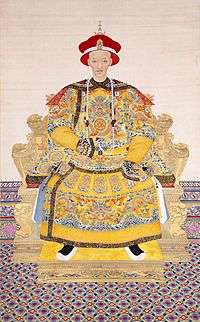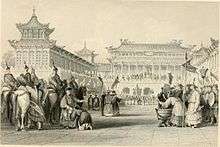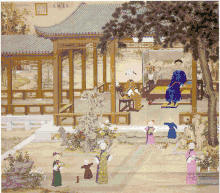Daoguang Emperor
The Daoguang Emperor (Chinese: 道光帝; pinyin: Dàoguāng Dì; 16 September 1782 – 26 February 1850) was the eighth Emperor of the Qing dynasty, and the sixth Qing emperor to rule over China properly, reigning from 1820 to 1850. His reign was marked by "external disaster and internal rebellion," that is, by the First Opium War, and the beginning of the Taiping Rebellion which nearly brought down the dynasty. The historian Jonathan Spence characterizes the Daoguang Emperor as a "well meaning but ineffective man" who promoted officials who "presented a purist view even if they had nothing to say about the domestic and foreign problems surrounding the dynasty."[1]
| Daoguang Emperor | |||||||||||||||||
|---|---|---|---|---|---|---|---|---|---|---|---|---|---|---|---|---|---|
 | |||||||||||||||||
| Prince Zhi of the First Rank (智親王) | |||||||||||||||||
| Reign | 1813–1820 | ||||||||||||||||
| 8th Emperor of the Qing dynasty | |||||||||||||||||
| Reign | 3 October 1820 – 26 February 1850 | ||||||||||||||||
| Predecessor | Jiaqing Emperor | ||||||||||||||||
| Successor | Xianfeng Emperor | ||||||||||||||||
| Born | Aisin Gioro Mianning (愛新覺羅·綿寧) 16 September 1782 (乾隆四十七年 八月 十日) Xiefang Hall, Forbidden City | ||||||||||||||||
| Died | 26 February 1850 (aged 67) (道光三十年 正月 十五日) Jiuzhou Qingyan Hall, Old Summer Palace | ||||||||||||||||
| Burial | Mu Mausoleum, Western Qing tombs | ||||||||||||||||
| Consorts | |||||||||||||||||
| Issue | Yiwei Xianfeng Emperor Yicong, Prince Dunqin of the First Rank Yixin, Prince Gongzhong of the First Rank Yixuan, Prince Chunxian of the First Rank Yihe, Prince Zhongduan of the Second Rank Yihui, Prince Fujing of the Second Rank Princess Shou'an of the First Rank Princess Shouzang of the Second Rank Princess Shou'en of the First Rank Princess Shouxi of the Second Rank Princess Shouzhuang of the First Rank | ||||||||||||||||
| |||||||||||||||||
| House | Aisin Gioro | ||||||||||||||||
| Father | Jiaqing Emperor | ||||||||||||||||
| Mother | Empress Xiaoshurui | ||||||||||||||||
| Daoguang Emperor | |||||||||||
|---|---|---|---|---|---|---|---|---|---|---|---|
| Chinese | 道光帝 | ||||||||||
| |||||||||||
Early years
The Daoguang Emperor was born in the Forbidden City, Beijing, in 1782, and was given the name Mianning (绵宁; 綿寧; Miánníng; Mien-ning). It was later changed to Minning (旻宁; 旻寧; Mǐnníng; Min-ning) when he became emperor. The first character of his private name was changed from Mian to Min to avoid the relatively common character Mian. This novelty was introduced by his grandfather, the reigning Qianlong Emperor, who thought it inappropriate to use a common character in the emperor's private name due to the longstanding practice of naming taboo.
Mianning was the second son of Prince Yongyan, the 15th son and heir of the Qianlong Emperor. Even though he was Yongyan's second son, he was first in line after Prince Yongyan to his grandfathers throne. This was because according to the dishu system, his mother, Lady Hitara, was Yongyan's primary spouse whereas his elder brother was born to Yongyan's concubine. Mianning was favoured by his grandfather, the Qianlong Emperor. He frequently accompanied his grandfather on hunting trips. On one such trip, at the age of nine, Mianning successfully hunted a deer, which greatly amused the Qianlong Emperor. The emperor would abdicate five years after that incident, in 1796, when Mianning was 14. Mianning’s father Prince Yongyan was then enthroned as the Jiaqing Emperor, after which he made Lady Hitara (Mianning's mother) his empress consort. The elderly Qianlong would live three more years in retirement before dying in 1799, aged 88, when Mianning was 17.
In 1813, while he was still a prince, Mianning also played a vital role in repelling and killing Eight Trigrams invaders who stormed the Forbidden City.
Reign

Khoja rebellion in Xinjiang

In September 1820, at the age of 38, Mianning inherited the throne after the Jiaqing Emperor died suddenly of unknown causes. He became the first Qing emperor who was the eldest legitimate son of his father. Now known as the Daoguang Emperor, he inherited a declining empire with Westerners encroaching upon the borders of China. The Daoguang Emperor had been ruling for six years when the exiled heir to the Khojas, Jahangir Khoja, attacked Xinjiang from Kokand in the Afaqi Khoja revolts. By the end of 1826, the former Qing cities of Kashgar, Yarkand, Khotan, and Yangihissar had all fallen to the rebels.[2][3] After a friend betrayed him in March 1827, Khoja was sent to Beijing in an iron litter and subsequently executed,[4] while the Qing Empire regained control of their lost territory.
First Opium War
During the Daoguang Emperor's reign, China experienced major problems with opium, which was imported into China by British merchants. Opium had started to trickle into China during the reign of the Yongzheng Emperor, but was limited to approximately 200 chests annually. By the time of the Qianlong era, this amount had increased to 1,000 chests, 4,000 chests by the Jiaqing era and more than 30,000 chests during the Daoguang era.
.jpg)
The Daoguang Emperor issued many imperial edicts banning opium in the 1820s and 1830s, which were carried out by Lin Zexu, whom he appointed as an Imperial Commissioner. Lin Zexu's efforts to halt the spread of opium in China led directly to the First Opium War. With the development of the First Opium War, Lin Zexu was made a scapegoat. The Daoguang Emperor removed his authority and banished him to Yili. Meanwhile, in the Himalayas, the Sikh Empire attempted an occupation of Tibet but was defeated in the Sino-Sikh war (1841–1842). On the coasts, the Qing Empire lost the war, exposing their technological and military inferiority to European powers, and ceded Hong Kong to the British in the Treaty of Nanjing in August 1842.
Anti-Christianity
In 1811, a clause sentencing Europeans to death for spreading Catholicism had been added to the statute called "Prohibitions Concerning Sorcerers and Sorceresses" (禁止師巫邪術) in the Great Qing Legal Code.[5] Protestants hoped that the Qing government would discriminate between Protestantism and Catholicism, since the law mentioned the latter by name, but after Protestant missionaries gave Christian books to Chinese in 1835 and 1836, the Daoguang Emperor demanded to know who were the "traitorous natives" in Guangzhou who had supplied them with books.[6]
Death and legacy
The Daoguang Emperor died on 26 February 1850 at the Old Summer Palace, 8 km/5 miles northwest of Beijing, being the last Qing emperor to pass away in that Palace before it was burnt down by Anglo-French troops during the Second Opium War, a decade later. He was succeeded by his eldest surviving son, Yizhu, who was later enthroned as the Xianfeng Emperor. The Daoguang Emperor failed to understand the intention or determination of the Europeans, or the basic economics of a war on drugs. Although the Europeans were outnumbered and thousands of miles away from logistical support in their native countries, they could bring far superior firepower to bear at any point of contact along the Chinese coast. The Qing government was highly dependent on the continued flow of taxes from southern China via the Grand Canal, which the British expeditionary force easily cut off at Zhenjiang. The Daoguang Emperor ultimately had a poor understanding of the British and the industrial revolution that Britain and Western Europe had undergone, preferring to turn a blind eye to the rest of the world, though the distance from China to Europe most likely played a part. It was said that the emperor did not even know where Britain was located in the world. His 30-year reign introduced the initial onslaught by Western imperialism and foreign invasions that would plague China, in one form or another, for the next one hundred years.
The Daoguang Emperor was interred in the Mu (慕; lit. "Longing" or "Admiration") mausoleum complex, which is part of the Western Qing Tombs, 120 kilometers/75 miles southwest of Beijing.
On a side note, the Daoguang Emperor was the last Qing emperor to be able to choose an heir among his sons since his successors either had only one surviving son or had no offspring.
Family


- Father: Yongyan, the Jiaqing Emperor (仁宗 顒琰; 13 November 1760 – 2 September 1820)
- Grandfather: Hongli, the Qianlong Emperor (高宗 弘曆; 25 September 1711 – 7 February 1799)
- Grandmother: Empress Xiaoyichun, of the Weigiya clan (孝儀純皇后 魏佳氏; 23 October 1727 – 28 February 1775)
- Mother: Empress Xiaoshurui, of the Hitara clan (孝淑睿皇后 喜塔臘氏; 2 October 1760 – 5 March 1797)
- Grandfather: He'erjing'e (和爾經額), served as a second rank literary official (總管) in the Imperial Household Department and a second rank military official (副都統), and held the title of a third class duke (三等公)
- Grandmother: Lady Wanggiya
- Consorts and Issue:
- Empress Xiaomucheng, of the Niohuru clan (孝穆成皇后 鈕祜祿氏; 1781 – 17 February 1808), fifth cousin eight times removed
嫡福晉 - Empress Xiaoshencheng, of the Tunggiya clan (孝慎成皇后 佟佳氏; 5 July 1792 – 16 June 1833)
嫡福晉→皇后- Princess Duanmin of the First Rank (端憫固倫公主; 29 July 1813 – 7 December 1819), first daughter
- Empress Xiaoquancheng, of the Niohuru clan (孝全成皇后 鈕祜祿氏; 24 March 1808 – 13 February 1840)
全貴人→全嬪→全妃→全貴妃→皇貴妃→皇后- Miscarriage (2 January 1824)
- Princess Duanshun of the First Rank (端順固倫公主; 8 April 1825 – 27 December 1835), third daughter
- Princess Shou'an of the First Rank (壽安固倫公主; 12 May 1826 – 24 March 1860), fourth daughter
- Married Demchüghjab (德穆楚克扎布; d. 1865) of the Naiman Borjigit clan on 15 November 1841
- Yizhu, the Xianfeng Emperor (文宗 奕詝; 17 July 1831 – 22 August 1861), fourth son
- Empress Xiaojingcheng, of the Khorchin Borjigit clan (孝靜成皇后 博爾濟吉特氏; 19 June 1812 – 21 August 1855), fifth cousin
靜貴人→靜嬪→靜妃→靜貴妃→皇貴妃..康慈皇貴妃→康慈皇太后- Yigang, Prince Shunhe of the Second Rank (順和郡王 奕綱; 22 November 1826 – 5 March 1827), second son
- Miscarriage at four months (28 June 1828)
- Yiji, Prince Huizhi of the Second Rank (慧質郡王 奕繼; 2 December 1829 – 22 January 1830), third son
- Princess Shou'en of the First Rank (壽恩固倫公主; 20 January 1831 – 15 May 1859), sixth daughter
- Married Jingshou (景壽; 1829–1889) of the Manchu Fuca clan in May/June 1845, and had issue (one son)
- Yixin, Prince Gongzhong of the First Rank (恭忠親王 奕䜣; 11 January 1833 – 29 May 1898), sixth son
- Imperial Noble Consort Zhuangshun, of the Uya clan (莊順皇貴妃 烏雅氏; 29 November 1822 – 13 December 1866)
琳貴人→秀常在→琳貴人→琳嬪→琳妃→琳貴妃..琳皇貴妃- Yixuan, Prince Chunxian of the First Rank (醇賢親王 奕譞; 16 October 1840 – 1 January 1891), seventh son
- Princess Shouzhuang of the First Rank (壽莊固倫公主; 24 March 1844 – 11 March 1935), ninth daughter
- Married Dehui (德徽; d. 1859) of the Bolod (博罗特) clan in December 1859 or January 1860 and had issue (daughter)
- Yihe, Prince Zhongduan of the Second Rank (鐘端郡王 奕詥; 14 March 1844 – 17 December 1868), eighth son
- Yihui, Prince Fujing of the Second Rank (孚敬郡王 奕譓; 15 November 1845 – 22 March 1877), ninth son
- Miscarriage (1848)
- Noble Consort Tong, of the Šumuru clan (彤貴妃 舒穆魯氏; 3 June 1817 – 1877)
睦貴人→彤嬪→彤妃→彤貴妃→彤貴人..彤嬪→彤貴妃- Seventh daughter (30 July 1840 – 27 January 1845)
- Princess Shouxi of the Second Rank (壽禧和碩公主; 7 January 1842 – 10 September 1866), eighth daughter
- Married Jalafungga (扎拉豐阿; d. 1898) of the Manchu Niohuru clan in November/December 1863
- Tenth daughter (4 May 1844 – 26 February 1845)
- Noble Consort Jia, of the Gogiya clan (佳貴妃 郭佳氏; 21 November 1816 – 24 May 1890)
佳貴人→佳嬪→佳貴人..佳嬪→佳妃→佳貴妃 - Noble Consort Cheng, of the Niohuru clan (成貴妃 鈕祜祿氏; 10 March 1813 – 10 May 1888)
成貴人→餘常在→成貴人..成嬪→成貴人→成嬪→成妃→成貴妃 - Consort He, of the Hoifa Nara clan (和妃 輝發那拉氏; d. 18 May 1836)
官女子→側福晉→和嬪→和妃- Yiwei, Prince Yinzhi of the Second Rank (隱志郡王 奕緯; 16 May 1808 – 23 May 1831), first son and heir presumptive for the greater part of his father's early reign
- Consort Xiang, of the Niohuru clan (祥妃 鈕祜祿氏; 9 February 1808 – 15 February 1861)
祥貴人→祥嬪→祥妃→祥貴人..祥嬪- Second daughter (2 March 1825 – 27 August 1825)
- Princess Shouzang of the Second Rank (壽臧和碩公主; 15 November 1829 – 9 August 1856), fifth daughter
- Married Enchong (恩崇; d. 1864) of the Manchu Namdulu (那木都魯) clan on 3 January 1843
- Yicong, Prince Dunqin of the First Rank (惇勤親王 奕誴; 23 July 1831 – 18 February 1889), fifth son; adopted by his uncle Miankai (綿愷) early on
- Consort Chang, of the Hešeri clan (常妃 赫舍里氏; 31 December 1808 – 10 May 1860)
珍貴人→珍嬪→珍妃→珍嬪→常貴人..常嬪 - Concubine Tian, of the Fuca clan (恬嬪 富察氏; 15 April 1789 – 21 August 1845)
側福晉→恬嬪 - Concubine Shun, of the Nara clan (順嬪 那拉氏; 28 February 1811 – 11 April 1868)
順常在..順貴人→順常在→順貴人→順嬪 - Concubine Yu, of the Shang clan (豫嬪 尚氏; 20 December 1816 – 24 September 1897)
玲常在→答應..常在→貴人→豫嬪 - Concubine Heng, of the Cai clan (恆嬪 蔡氏; d. 28 May 1876)
宜貴人→宜常在→答應..常在→貴人→恆嬪
- Empress Xiaomucheng, of the Niohuru clan (孝穆成皇后 鈕祜祿氏; 1781 – 17 February 1808), fifth cousin eight times removed
In fiction and popular culture
- Portrayed by Lo Chun-shun in The Rise and Fall of Qing Dynasty (1988)
- Portrayed by Du Zhiguo in Sigh of His Highness (2006)
- Portrayed by Sunny Chan in Curse of the Royal Harem (2011)
- Portrayed by Nono Yeung in Succession War (2018)
See also
- Chinese emperors family tree (late)
References
Citations
- Spence 1990, pp. 149, 166.
- Millward 1998, p. 34.
- "Zhuozhou Celebrity — Lu Kun (涿州名人-卢坤)". Xinhuanet (in Chinese). 15 June 2012. Archived from the original on 21 January 2013. Retrieved 21 February 2014.
- Rahul 2000, p. 98.
- Maclay 1861, pp. 336–337.
- Maclay 1861.
- Qin ding da Qing hui dian (Jiaqing chao)0. 1818. p. 1084.
Sources
- Maclay, Robert Samuel (1861). Life Among the Chinese: With Characteristic Sketches and Incidents of Missionary Operations and Prospects in China. New York, NY: Carlton & Porter.CS1 maint: ref=harv (link)
- Millward, James A. (1998). Beyond the Pass: Economy, Ethnicity, and Empire in Qing Central Asia, 1759-1864. Stanford University Press. ISBN 9780804729338.CS1 maint: ref=harv (link)
- Rahul, Ram (2000). March of Central Asia. Indus Publishing Company. ISBN 9788173871092.CS1 maint: ref=harv (link)
- Spence, Jonathan D. (1990). The Search for Modern China. Norton. ISBN 9780393307801.CS1 maint: ref=harv (link)
Further reading
- Jane Kate Leonard. Controlling from Afar: The Daoguang Emperor's Management of the Grand Canal Crisis, 1824–1826. Michigan Monographs in Chinese Studies. Ann Arbor: Center for Chinese Studies, University of Michigan, 1996. ISBN 0892641142. Shows the Daoguang Emperor in a competent and effective mode when dealing with a crisis early in his reign.
- Pierre-Etienne Will, "Views of the Realm in Crisis: Testimonies on Imperial Audiences in the Nineteenth Century." Late Imperial China 29, no. 1S (2008): 125–59. JSTOR Link. Uses transcripts of imperial audiences to present Daoguang as more a victim of circumstances than the bumbling administrator in many accounts.
- Gützlaff, Karl (1852). Life of Taou-Kwang, Late Emperor of China. London, England: Smith, Elder & Co. The only biography of the Daoguang Emperor; written by a missionary and contemporary.
- Evelyn S. Rawski, The Last Emperors: A Social History of Qing Imperial Institutions (Berkeley: University of Californian Press, 2001) ISBN 0-520-22837-5.
- Daily life in the Forbidden City, Wan Yi, Wang Shuqing, Lu Yanzhen. ISBN 0-670-81164-5.
- 《清史稿》 [Draft History of Qing] (in Chinese).
External links

Daoguang Emperor Born: 16 September 1782 Died: 26 February 1850 | ||
| Regnal titles | ||
|---|---|---|
| Preceded by Jiaqing Emperor |
Emperor of the Qing dynasty Emperor of China 1820–1850 |
Succeeded by Xianfeng Emperor |